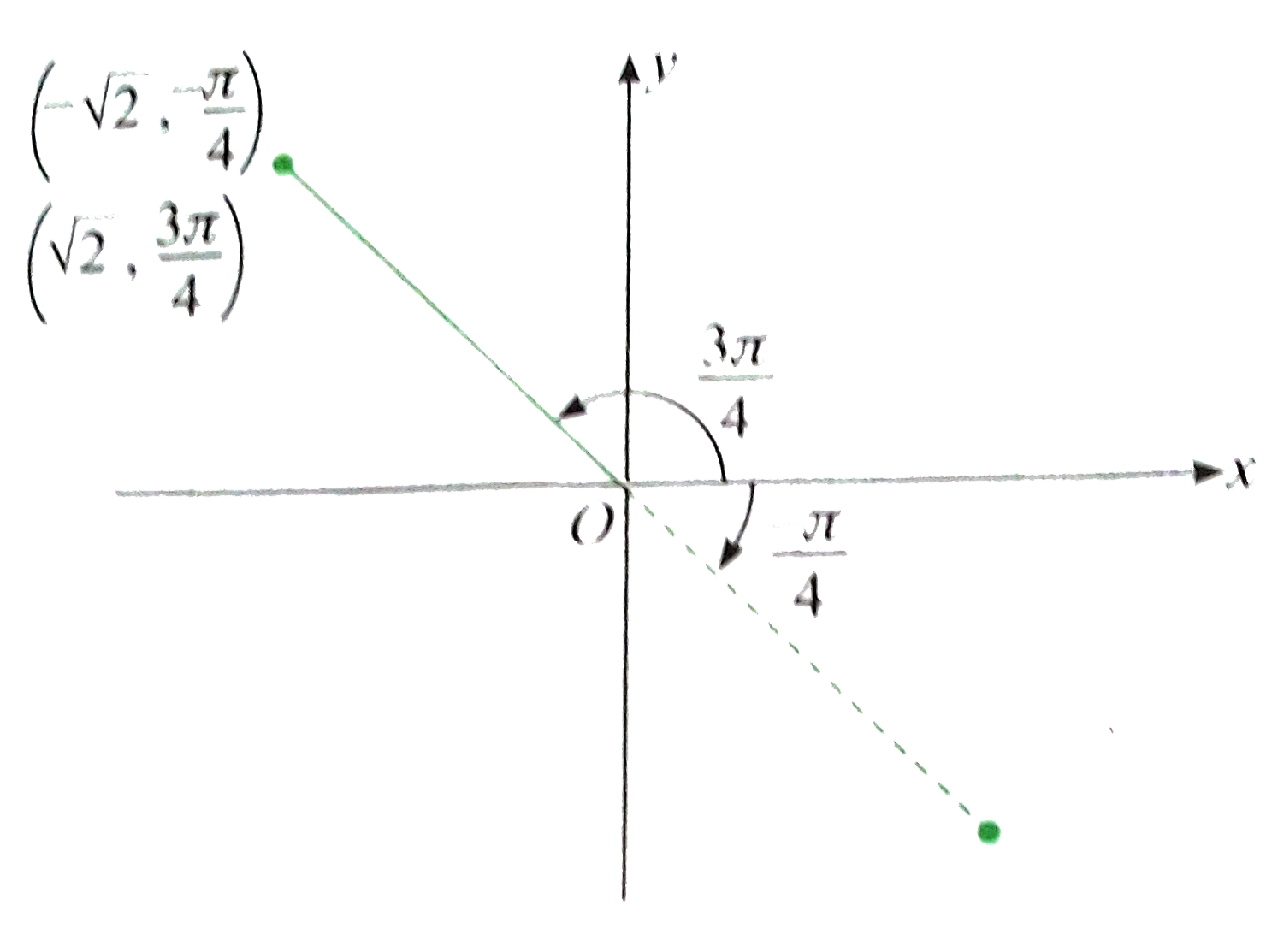Convert the following Cartesian coordinates to the corresponding polar coordinates using positive r and negative r. (i) (ii)(iii)((iv)(v)−1,1(vi))(vii) (viii) (ii) (ix)(x)((xi)(ξi)2,−3(xiii))(xiv) (xv)
(i) For the second quadrant point (x,y)≡(−1,1), we have
tanθ=yx=−1⇒θ=3π4

Using positive r, we have
r=√x2+y2=√(−1)2+(1)2=√2
So, one set of polar coordinates is (r,θ)≡(√2,3π/4)
Using negative r, we have coordinates =(−√2,−π/4)
(ii) For the fourth quadrant point (x,y)≡(2,−2), we have
tanθ=−32
⇒θ=tan−1(−32)=−tan−1^32
Using positive r, we have
r=√x2+y2=√(−3)2+(2)2=√13
So, one set of polar coordinates is
(r,θ)≡(√13,−tan−132)

Using negative r, we have coordinates
=(−√13,π−tan−132)
Topper's Solved these Questions
- COORDINATE SYSYEM BOOK - CENGAGE ENGLISHCHAPTER - COORDINATE SYSYEM EXERCISE - Illustration1.53
1 Videos
- COORDINATE SYSYEM BOOK - CENGAGE ENGLISHCHAPTER - COORDINATE SYSYEM EXERCISE - Illustration1.54
1 Videos
- COORDINATE SYSYEM BOOK - CENGAGE ENGLISHCHAPTER - COORDINATE SYSYEM EXERCISE - Illustration1.51
1 Videos
- COORDINATE SYSTEMBOOK - CENGAGE ENGLISHCHAPTER - COORDINATE SYSTEMEXERCISE - Multiple Correct Answers Type
2 Videos
- CROSS PRODUCTS BOOK - CENGAGE ENGLISHCHAPTER - CROSS PRODUCTS EXERCISE - DPP 2.2
13 Videos
Similar Questions
Convert the following Cartesian coordinates to the cooresponding polar coordinates using positive r.
(i) (1,−1)
(ii) (−3,−4)
View SolutionConvert the following points from polar coordinates to the corresponding Cartesian coordinates. (i) (ii)(iii)((iv)(v)2,(vi)πvii3(viii)(ix)(x))(xi) (xii) (ii) (xiii)(ξv)((xv)(xvi)0,(xvii)πxviii2(xix)(×)(×i))(xxii) (xxiii) (iii) (xxiv)(×v)((xxvi)(×vii)−√(xxviii)2(xxix)(xxx),(×ξ)πxxxii4(xxxiii)(×ξv)(×xv))(xxxvi) (xxxvii)
View Solution
Knowledge Check
If (1+i1−i)x=1∀n∈N is (i) x = 2n+1 (ii) x =4n (iii) x=2n (iv) x=4n+1
Ax = 2n+1Bx =4nCx=2nDx=4n+1
Convert the following polar coordinates to its equivalent Cartesian coordinates. (i) (ii)(iii)2,π)(iv) (v) (ii) (vi)(vii)((viii)(ix)√(x)2(xi)(xii),(ξii)πxiv6(xv)(xvi)(xvii))(xviii) (xix) (iii) (xx)(×i)((xxii)(×iii)−3,−(xxiv)πxxv6(xxvi)(×vii)(×viii))(xxix) (xxx)
View SolutionNumber of four-digit numbers of the form N=abcd which satisfy following three conditions (i) (ii)(iii)4000≤N<6000(iv) (v) (vi) (vii)N(viii) (ix) is a multiple of 5 (x) (xi)(ξi)3≤b<c≤6(xiii) (xiv) is equal to N, then the value of N/3 is ____.
View SolutionGiven points P(2,3),Q(4,−2),andR(α,0) (i) Find the value of (ii)α(iii) (iv) if (v)(vi)PR+rQ(vii) (viii) is minimum (ix) Find the value of (x)α(xi) (xii) if (xiii)(ξv)|(xv)PR−RQ|(xvi) (xvii) is maximum
View SolutionConvert the following in the polar form :
(i) 1+7i(2−i)2
(ii) 1+3i1−2i
View SolutionFind the following products using appropriate identities:(i) (x+3) (x+3) (ii) (x−3)(x+5)
View SolutionConvert the following in the form of (a+ib) :
(i) (1+i)4
(ii) (−3+12i)3
(iii) (1−i)(3+4i)
(iv) (1+i)(1+2i)(1+3i)
(v) 3+5i6−i
(vi) (2+3i)22+i
(vii) (1+i)(2+i)(3+i)
(viii) (2−i)−3
View SolutionSimplify the following :
(i) i97
(ii) i8
(iii) 1i3
(iv) (−i)14
(v) i−22
(vi) i−63
View Solution
